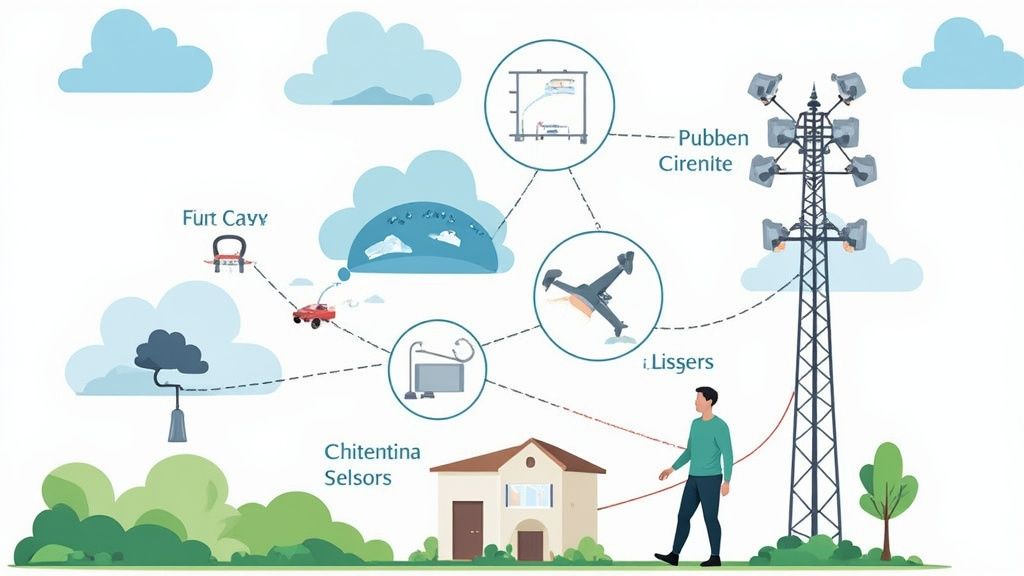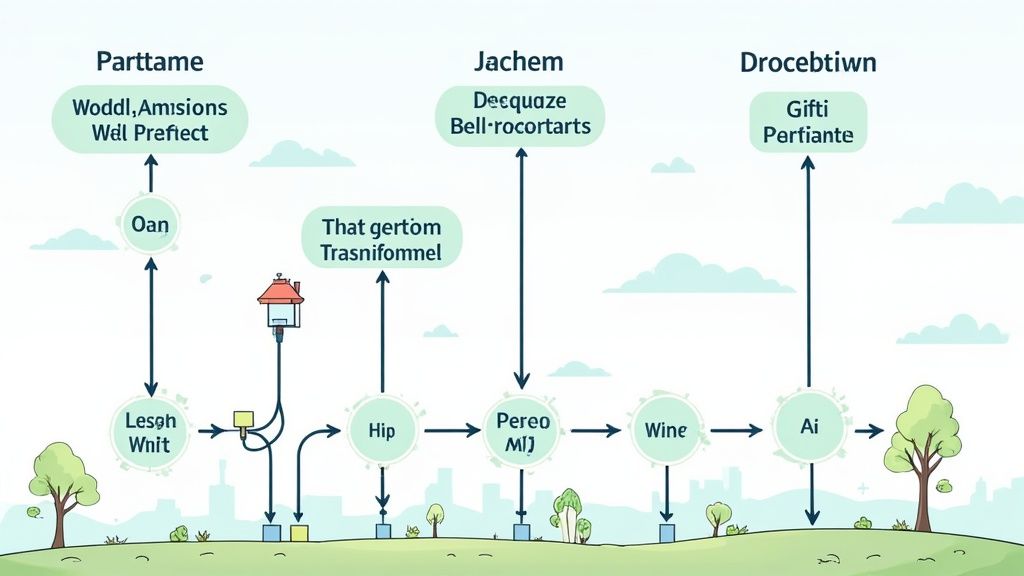What is AQM: The Complete Guide to Air Quality Management Solutions

Understanding Air Quality Management: Beyond the Basics

Air quality management (AQM) combines different elements working together to clean up and protect the air we breathe. From measuring pollution levels to working with communities, successful AQM programs take a complete approach. They need to adapt as conditions change while staying focused on clear goals for air quality improvement.
Core Principles of Successful AQM
A few essential principles guide effective air quality management. Let's explore what makes these programs work:
-
Careful Monitoring: Programs need accurate, detailed data to understand where pollution comes from and how it spreads. New sensor technology now provides real-time local readings, making it easier to spot problem areas quickly.
-
Science-Based Methods: Good programs rely on solid research about air chemistry, health impacts, and which cleanup approaches actually work. The science helps target efforts where they'll do the most good.
-
Smart Solutions: Once monitoring shows where problems exist, programs can focus on fixing specific issues. This might mean new rules for factories, better transportation options, or teaching people how to reduce pollution.
-
Quick to Adapt: Air quality challenges keep changing as cities grow and industries evolve. Programs must stay flexible and use new tools and information to keep making progress.
Evaluating Air Quality: Frameworks and Metrics
To know if air quality programs succeed, we need clear ways to measure results. This helps show what's working and where to improve.
-
Air Quality Index (AQI): This common tool translates complex air data into simple ratings people can understand. It helps everyone make smart choices about outdoor activities based on current conditions.
-
Health Impact Studies: These look carefully at how air quality affects public health. For example, studies might examine whether a new low-emission zone in a city center helped reduce asthma cases.
-
Pollution Records: Tracking emissions from different sources shows who contributes most to air pollution. If data reveals that older diesel trucks cause lots of particle pollution, cities might focus on helping fleet owners switch to cleaner vehicles.
Air quality management takes constant work and attention to detail. Success comes from understanding how human activities affect air quality and using that knowledge to make smart improvements. This understanding grew from key events in history that showed why protecting air quality matters for public health. Let's look at how those events shaped today's approach to clean air.
Game-Changing Moments in Air Quality Protection

Air quality management started as basic responses to environmental disasters before developing into the comprehensive system we know today. Through several key historical events, we learned just how closely human activities affect the air we breathe. These lessons shaped modern approaches to protecting air quality and public health.
The Donora Smog: A Wake-Up Call for America
In 1948, the small town of Donora, Pennsylvania experienced an environmental disaster that changed air quality regulation in America. A heavy smog trapped industrial pollutants over the town for several days, killing 20 people and sickening thousands more. The Donora tragedy opened eyes across the country to the deadly effects of unchecked industrial emissions. Public outrage led directly to the Air Pollution Control Act of 1955 – America's first federal law addressing air pollution. This marked an important shift from scattered local efforts to a unified national strategy.
The Great Smog of London: A Catalyst for Global Change
Just a few years after Donora, London faced its own air quality crisis. The Great Smog of 1952 blanketed the city in thick pollution for days, causing an estimated 4,000 deaths. This disaster spurred the UK to pass its Clean Air Act in 1956, which put strict limits on smoke emissions and created smoke-free zones. The UK's response became a model for other countries facing similar challenges, showing how strong laws could effectively protect public health from air pollution.
The Rise of Monitoring Networks: A Data-Driven Approach
As awareness of air pollution grew, scientists and officials needed better ways to track and measure it. The UK led the way in 1961 by creating the world's first national air pollution monitoring system. This network of 1,200 sites measured key pollutants like black smoke and sulfur dioxide across the country. By 1998, they expanded it further to include both urban and rural areas, building an even more complete picture of air quality patterns. This focus on data collection and analysis remains central to effective air quality management today.
Success in the South Coast Air Basin: Lessons Learned
Real progress is possible with sustained effort, as shown by California's South Coast Air Basin. Between 1980 and 2020, this region saw a major drop in days with unhealthy ozone levels. This improvement came through stronger regulations, better technology, and ongoing work to cut emissions from many sources. The South Coast's success offers a clear example of how well-designed air quality programs can deliver meaningful results. Their experience continues to guide other regions working to clean up their air and protect public health.
Building Effective Monitoring Networks That Actually Work

Looking at the history and impact of air quality monitoring shows us that good monitoring is essential for making real improvements. A monitoring network needs careful planning and ongoing attention to provide useful data that drives action. Let's explore what makes monitoring networks truly effective.
Evolution of Monitoring: From Basic to Advanced
The UK's first air quality monitoring system in 1961 marked an important starting point, with 1,200 sites measuring basic pollutants like black smoke and sulfur dioxide. However, these early efforts had major limitations. For instance, during the Donora Smog disaster, the lack of real-time data made it hard for officials to respond quickly. Today's systems provide instant readings across many more locations, helping cities spot and address pollution problems much faster.
Getting Better Data Through New Technology
Recent improvements in sensors, data analysis, and communication have made monitoring much more powerful. Small, affordable sensors can now track pollution block-by-block. Some cities even put sensors on vehicles to map pollution patterns across neighborhoods. New computer analysis tools help identify pollution sources and predict air quality trends. This detailed, local data helps cities target their cleanup efforts where they're needed most.
Implementing Effective Monitoring: Best Practices
Building a good monitoring network takes careful thought about several key factors. Monitors need strategic placement based on wind patterns, geography, and pollution sources to capture accurate data. Regular equipment checks and updates keep readings reliable. Smart data management turns raw numbers into useful insights.
| Feature | Benefit |
|---|---|
| Strategic Placement | Captures representative data across the monitored area |
| Regular Calibration | Ensures data accuracy and reliability |
| Data Management | Facilitates efficient data storage, retrieval, and analysis |
| Real-Time Analysis | Enables rapid responses to pollution events |
| Community Involvement | Fosters trust and empowers local action on air quality issues |
Getting local residents involved in data collection helps in two important ways: it provides more data points and builds community support for air quality improvements. When people can see pollution levels in their own neighborhoods, they're more likely to support cleanup efforts. This combination of good monitoring practices and community engagement creates systems that actually help cities breathe easier.
Real Success Stories: When AQM Creates Lasting Change
Real-world examples demonstrate how effective air quality management (AQM) can transform communities. By examining these success stories, we can understand the practical steps that lead to cleaner air and healthier populations.
The South Coast Air Basin: A Case Study in Effective AQM
The South Coast Air Basin in California shows what's possible when communities commit to improving air quality. Once known for severe smog problems, the region achieved remarkable progress between 1980 and 2020. The numbers tell a compelling story: In 1980, unhealthy ozone levels occurred on 167 days under the old federal standard. By 2020, that number dropped to just 27 days – even with today's stricter standards. This improvement came through focused action on multiple fronts, including tighter industrial regulations and widespread adoption of cleaner vehicles.
Key Strategies for Success: Lessons From the Field
The South Coast success offers clear lessons for other regions. Strong enforcement of emissions standards proved essential – rules only work when followed. Just as important was getting everyone involved, from business owners to local residents. When people understood their role in creating cleaner air, they became more invested in solutions. New technology also played a vital role, as better equipment and processes helped cut pollution levels. These elements combined to create lasting positive change.
Overcoming Obstacles in AQM Implementation
The path to cleaner air isn't always smooth. Programs need steady funding to keep going. They also require ongoing political backing and public support through the years. Changing how people travel or use energy means giving them good alternatives and helping them understand why changes matter. The South Coast faced these same challenges but found ways forward through persistent community outreach and smart policy choices.
Building a Framework for Lasting Change
The South Coast story shows that improving air quality takes a complete approach. Success comes from combining strong rules, community involvement, better technology, and continuous public education. Their experience provides a practical guide for other areas working toward cleaner air. By studying what worked in the South Coast and understanding AQM principles, communities can create programs that protect public health for generations to come.
Navigating Modern AQM Challenges and Opportunities

Getting air quality management (AQM) right means tackling some significant hurdles head-on. These challenges can prevent even well-designed programs from making real progress. Understanding and working through these obstacles is essential for creating meaningful improvements in air quality.
Bridging the Data Gap: Expanding Monitoring Reach
Most cities rely heavily on expensive regulatory monitors that are placed far apart, creating blind spots in air quality data. This sparse monitoring network makes it hard to identify specific pollution sources and target solutions effectively. For instance, a residential area near a factory might experience much higher pollution levels than what the nearest monitoring station shows. This points to a clear need for more detailed, local-level data collection.
Engaging Stakeholders: Building Community Partnerships
Success in AQM depends on working together. Getting residents, businesses, and government agencies involved helps build support and ensures programs work for everyone affected by air pollution. Many current programs struggle with this aspect. When communities feel left out, they often lose faith in the process. Similarly, without buy-in from businesses and other pollution sources, it's hard to put effective reduction plans into action. Good partnerships and open communication make all the difference.
Integrating New Technologies: Embracing Innovation
As tools for measuring and managing air quality improve, AQM programs need to keep pace. Adding new capabilities like low-cost sensors, mobile monitoring units, and better data analysis can give us much deeper insights into air quality issues. But bringing in these new tools has its challenges. For example, making sure low-cost sensors give accurate readings is crucial. Combining data from different sources also requires specific skills. Still, staying current with new technology is key to building better AQM programs.
From Challenges to Opportunities: A Path Forward for AQM
While these issues are real, they also show us where we can make things better. By expanding monitoring networks and including citizen science projects, we can get a clearer picture of local air quality. With this detailed information, we can create more focused solutions. Building strong relationships with communities and bringing different groups together helps ensure solutions work and last. This approach gives communities more say in their air quality and helps create real change. Finally, smart use of new technology can help us build stronger, more responsive AQM systems. Taking advantage of these opportunities can lead to major improvements in public health and cleaner air for everyone.
Creating Your AQM Success Blueprint
Effective air quality management requires a structured approach. While it may seem complex at first, breaking it down into key components can help create meaningful improvements in air quality. Let's explore the essential elements and practical steps to build an AQM program that works.
Essential Components of an Effective AQM Program
A successful AQM program relies on several interconnected elements working together. Each component plays a vital role in achieving better air quality outcomes.
-
Robust Monitoring: Getting accurate air quality data is the foundation. This means placing monitoring equipment strategically, maintaining calibration, and managing data effectively. Consider the tragic Donora Smog event of 1948, where 20 people died and thousands fell ill. Real-time monitoring could have helped officials respond faster and potentially reduce the impact.
-
Data-Driven Decision Making: Raw data needs careful analysis to be useful. Modern AQM uses various data sources, from low-cost sensors to citizen science projects, to pinpoint pollution sources. For example, if data shows high particulate matter from a specific industrial area, you can focus regulations and solutions there.
-
Community Engagement: Local support is crucial for lasting change. When residents, businesses and other stakeholders participate actively, solutions become more relevant and sustainable. Many AQM programs struggle without community buy-in, so making engagement a priority helps ensure better outcomes.
-
Adaptive Management: Air quality challenges change over time, so your approach needs flexibility. Like a ship adjusting its course, AQM programs must evolve based on new data and community needs. California's South Coast Air Basin shows this works – they significantly reduced unhealthy ozone days between 1980-2020 while meeting stricter standards.
Implementing Your AQM Blueprint: A Step-by-Step Guide
Here's how to put these components into action:
-
Assess Current Air Quality: Start by understanding your baseline through existing data and key pollutant analysis.
-
Define Goals and Objectives: Set specific, measurable targets for pollutant reduction within clear timeframes.
-
Develop a Monitoring Plan: Choose appropriate monitoring equipment, establish data procedures, and implement quality controls.
-
Engage Stakeholders: Create channels for community input and collaboration. Build relationships with residents and businesses.
-
Implement Control Strategies: Put specific measures in place to reduce emissions, from regulations to community initiatives.
-
Evaluate and Adapt: Track progress regularly, gather feedback, and adjust your approach as needed.
Measuring Success: Key Metrics and Indicators
Track these key measures to assess your AQM program's effectiveness:
| Metric | Description |
|---|---|
| Pollutant Concentrations | Measure levels of specific pollutants like ozone, particulate matter, and sulfur dioxide. |
| Air Quality Index (AQI) | Provides a simplified rating of air quality based on pollutant concentrations. |
| Health Outcomes | Track changes in respiratory illnesses, cardiovascular problems, and other health issues related to air quality. |
| Emissions Reductions | Measure reductions in pollutant emissions from various sources. |
| Community Feedback | Gather input from residents and businesses about their perceptions of air quality and program effectiveness. |
Building an effective AQM program takes ongoing commitment and teamwork. By following this blueprint and regularly evaluating your efforts, you can create lasting improvements in air quality that benefit your entire community.
Want to improve your customer support? SupportMan integrates Intercom ratings directly into Slack, giving you real-time insights. Try SupportMan's free trial today: https://supportman.io
What to do next
Whenever you're ready, here's three ways we can help you scale your support org:
- Claim your free Support Manager Handbook. It's a free 30+ page guide filled with strategies, tactics, and best practices for scaling your support org. Download it here.
- Subscribe to our Support Ops newsletter to get the latest updates here.
- Set up Internal Documentation with Tettra to start automatically answering the questions you get in Slack. Here's how.

